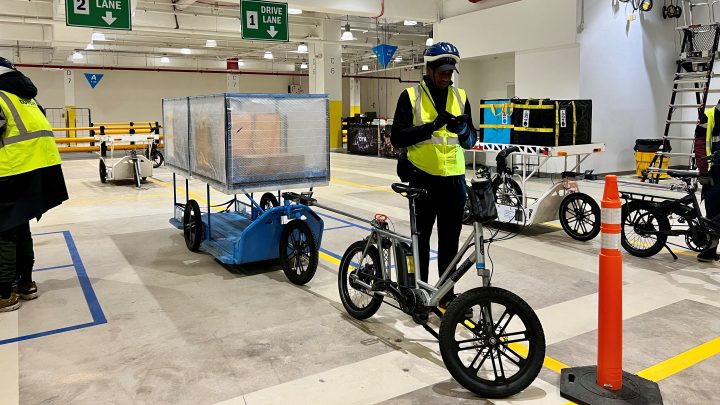
Package deliveries are clogging city streets

It’s a rainy evening in New York City, as in flash flood warning kind of rain. But it’s nothing Michael Singh hasn’t seen.
“Yes, rain, snow, high winds, all of it,” said Singh, who’s been a bike messenger for seven years and started with Amazon a few months ago. He begins his shift in a warehouse where he loads boxes onto an e-bike trailer the size of a bathtub. “This is a little light today. I’m guessing because of the rain.”
This cargo bike delivery program is a pilot with the City of New York. In a place as dense as Manhattan, trucks aren’t efficient.
“You know, going stop by stop, double parking, congesting the streets,” said Jessica Schumer, who leads New York City public policy for Amazon.
It’s a problem that’s gotten worse in the last few years. Between 2019 and 2020, U.S. parcel volume grew almost 40%, to 20 billion packages. By 2028, as many as 32 billion packages are projected to be shipped in the U.S.
And it’s not just about how much people are ordering, but where they’re getting things delivered. Before the pandemic, parcel delivery was often concentrated in business districts. A lot of people had stuff delivered to their office to avoid porch pirate theft. Now, more one-off deliveries are happening in residential areas.
“There’s no doubt that e-commerce and the ability to have goods delivered directly to your home has changed the way people shop in cities,” said Kelly Rula, who directs the Urban Freight Lab at the University of Washington. “It’s had upstream effects on how the transportation system was impacted.”
In Manhattan, for instance, truck speeds dropped to as low as seven miles an hour.
“That was a very dramatic change that cities had to grapple with kind of immediately,” said Rula.
This isn’t just an issue in New York City. Miami, Boston, Portland and other cities are running cargo bike programs to try to make the most expensive and emissions heavy piece of the logistics chain — last mile delivery — more efficient.
Rula said retailers and shipping companies need to be part of the solution, too.
“It takes an ecosystem to be successful from a business perspective,” she said. “And I think we’ve unfortunately seen some failures because this is not necessarily a slam dunk profitability pay at this point.”
In other words, companies are probably not going to come up with a whole new way of delivering packages unless it helps their bottom lines. Parcel delivery on foot or bikes can reduce costs, but the infrastructure has to be just right, with, say, new bike lanes or warehouse friendly zoning. Cities also need to take both a carrot and stick approach.
“We identified some incentives that can sweeten the pot,” said Diniece Mendes, director of freight mobility at New York City’s Department of Transportation. Carrots include special loading zones and sticks include congestion pricing.
But Mendes says consumers also need to help ease congestion on city streets.
“Freight activity generally, it responds directly to supply and demand for goods, which is really influenced by some of the decisions we make on a day to day,” said Mendes.
Getting consumers to resist the piecemeal purchases that are possible with free shipping takes more carrots and sticks. Some retailers incentivize customers to bundle deliveries. And states like Colorado and Minnesota require or will soon require consumers to pay a fee on some retail deliveries.
Fewer packages would make Singh’s job easier. Some of his customers order so often that he knows their schedules.
“I have one customer, she’s in this area, she’s never home before 8:30,” said Singh. “Maybe she’s there today, but she may not be.”
Singh sets the package down outside the door, takes a photo and hops on his bike to his next stop. In the nearly 20 minutes it took me to go by car two miles across Manhattan, Singh biked the distance and made nine deliveries in the rain.
Correction (March 25, 2024): A previous version the photo caption misstated Michael Singh’s relationship with Amazon.
There’s a lot happening in the world. Through it all, Marketplace is here for you.
You rely on Marketplace to break down the world’s events and tell you how it affects you in a fact-based, approachable way. We rely on your financial support to keep making that possible.
Your donation today powers the independent journalism that you rely on. For just $5/month, you can help sustain Marketplace so we can keep reporting on the things that matter to you.











